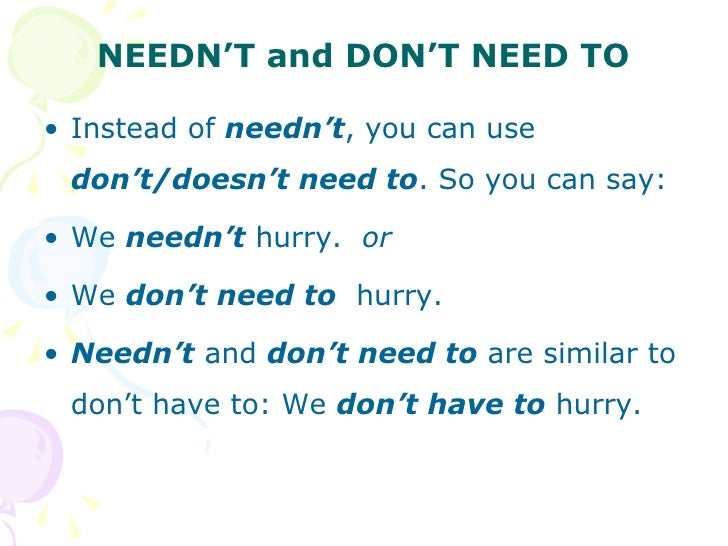One more common way to express obligation, necessity or a lack of obligation is with the semi-modal ‘need’. A semi-modal is a word that acts like both a modal verb and a main verb.
Present and Future
‘Need’ as a modal
As a modal verb, ‘need’ is most typically used in negative sentences or in affirmative sentences with a negative meaning. It expresses absence of necessity or obligation, and it is followed by a bare infinitive:
- Nobody need think that we are rich.
- She need not arrive (needn’t arrive) so early.
- If you want good results, you will need to work harder.
‘Need’ as a modal verb also occurs in interrogative sentences, but this use is much more formal:
- Need you make so much noise?
If used in statements, ‘need to’ is often used in the same context as ‘have to’ meaning necessity, but many times, ‘need to’ is used to express something that is less urgent, something in which you have a choice:
- I have to work late tonight.
- I need to work late tonight.
‘Need’ as a main verb
We can use main verb ‘need’ as an alternative to semi-modal ‘need’. Main verb ‘need’ is followed by to and it changes with person, number and tense:
- I, you, we, they – need to
- She, he, it – needs to
- I, you, she, he, it, we, they – needed to
‘Need’ as a main verb expresses that something is necessary. We can use it in affirmative, negative and interrogative sentences.
- Do you have a minute? I need to talk to you about something.
- I don’t need to be told that I should lose weight.
- Do you need to use the hairdryer?
Compare:
| Semi-modal need | Main verb need |
| Need it be so dark in here? (formal) | Does it need to be so dark in here? |
| You needn’t mention this to your father. | You don’t need to mention this to your father. |
In these examples, the meaning is the same for semi-modal need and main verb need + to.
To summarize:



Talking about Necessity in the past
The past tense of the main verb ‘need to’ is ‘needed to‘:
- I needed to have my hair cut.
- Why did they need to change the lock?
In the simple past negative form, we use ‘didn’t’ with ‘need’ to denote no obligation in the past.
- I didn’t need to arrive so early.
‘Need’ as a modal does not have a past tense form. ‘Needn’t + perfect bare infinitive’ (have + past participle), however, denote actions which were performed but were unnecessary:
- We needn’t have bought any milk. We still have plenty at home. (we bought some milk, but it wasn’t necessary)
- She needn’t have given me such an expensive present.
Talking about Necessity in the future
The future tense of the main verb ‘need to’ is ‘will need to‘:
will need to + infinitive
- I will need to drink a few cups of coffee in order to stay awake.
Passive Voice
‘Need’ can also be used with the passive voice. We use it to refer to tasks that the speaker is probably not going to do personally or when it is not important to know who is going to complete the action.
- My car needs to be washed.
- The dog needs to be fed.
- The building needs to be inspected by the city.
- My hair doesn’t need to be cut yet.
| Note: The negative form uses ‘do/does/did’. |
We can use a gerund with ‘need’. This structure is used in the same way as above. In this case, the gerund carries a passive meaning. Usually, the situations involve fixing or improving things:
- My house needs painting.
- My house needs to be painted.
- The house doesn’t need painting right now.
- This floor needs fixing.
- This floor needs to be fixed.
Note that the structures with to-infinitive and gerund are completely interchangeable.
This video from OnScreen Academy explains the usage of the verb ‘need’ in different tenses and meanings:
See also: